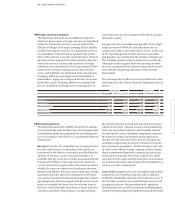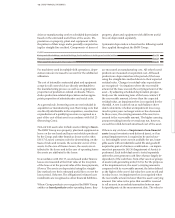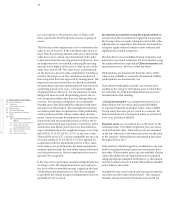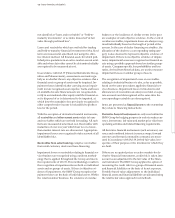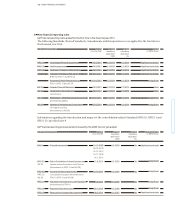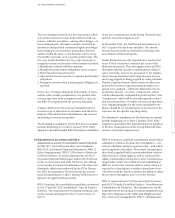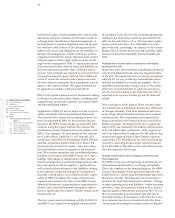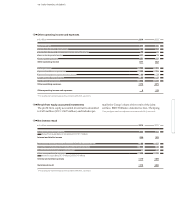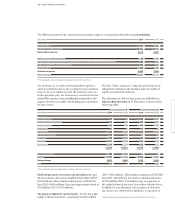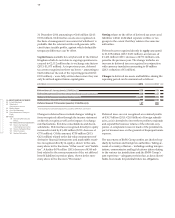BMW 2014 Annual Report Download - page 111
Download and view the complete annual report
Please find page 111 of the 2014 BMW annual report below. You can navigate through the pages in the report by either clicking on the pages listed below, or by using the keyword search tool below to find specific information within the annual report.
111 GROUP FINANCIAL STATEMENTS
The new Standard is based on a five-step model, which
sets out the rules for revenue from contracts with
cus-
tomers, with the exception – among other things – of
lease arrangements, insurance contracts, financial
in-
struments and specified contractual rights and obliga-
tions
relating to non-monetary transactions between
entities within the same sector. Revenue can be recog-
nised either over time or at a specific point in time. The
five-step model describes the five steps necessary to
recognise revenue on the basis of the transfer of control:
1. Identify the contract with the customer
2. Identify the performance obligations in the contract
3. Determine the transaction price
4. Allocate the transaction price to separate performance
obligations
5. Recognise revenue when a performance obligation is
satisfied.
In the case of multi-component transactions or trans-
actions
with variable consideration, it is possible that
revenue may have to be recognised earlier or later un-
der IFRS 15 compared with the previous Standard.
A major difference to the previous Standard is the in-
creased scope of discretion for estimates and the intro-
duction of thresholds that could influence the amount
and timing of revenue recognition.
The Standard is mandatory for the first time for annual
periods beginning on or after 1 January 2017. Early
adoption is permitted under IFRS. The impact of adoption
Adjustments in accordance with IAS 8
Adjustments as a result of consolidation-related Standards
In May 2011, the IASB issued three new Standards –
IFRS 10 (Consolidated Financial Statements), IFRS 11
(Joint Arrangements), IFRS 12 (Disclosure of Interests
in Other Entities) – as well as amendments to IAS 27
(Separate
Financial Statements) and to IAS 28 (Invest-
ments in Associates and Joint Ventures), all relating
to accounting for business combinations. The three new
Standards, which were endorsed by the EU in Decem-
ber 2012, are mandatory for the first time for annual
periods beginning on or after 1 January 2014 and are re-
quired to be applied retrospectively.
IFRS 10 replaces the consolidation guidelines contained
in IAS 27 and SIC-12 (Consolidation – Special Purpose
Entities). The requirements for separate financial state-
ments remain unchanged in the revised version of
IAS 27.
of the new requirements on the Group Financial State-
ments is currently being assessed.
In December 2014, the IASB issued Amendments to
IAS 1 as part of its disclosure initiative. The amend-
ments relate primarily to clarifications relating to the
presentation of financial reports.
Firstly, disclosures are only required to be made in the
notes if their inclusion is material for users of the
finan cial statements. This also applies when an IFRS
Standard explicitly specifies a minimum list of
disclo-
sures. Secondly, items to be presented in the balance
sheet, income statement and comprehensive income
can
be aggregated or disaggregated by using subtotals.
Thirdly, it clarifies that an entity’s share of other com-
prehensive income of equity-accounted entities is re-
quired to be analysed – within the Statement of
Com-
prehensive Income – to show “components, which
will
be subsequently reclassified to profit and loss” and
“components, which will be not subsequently reclassi-
fied to profit and loss”. Fourthly, it is stressed that there
is no standard template for the notes and that the em-
phasis should be on structuring the notes based on the
relevance for the specific reporting entity.
The Standard is mandatory for the first time for annual
periods beginning on or after 1 January 2016. Early
adoption is permitted. The potential impact of adoption
of the new requirements on the Group Financial State-
ments is currently being assessed.
IFRS 10 introduces a uniform consolidation model which
establishes control as the basis for consolidation – con-
trol of a subsidiary entity by a parent entity – and which
can be applied to all entities. The control concept must
therefore be applied both to parent-subsidiary relation-
ships based on voting rights as well as to parent-sub-
sidiary relationships arising from other contractual ar-
rangements.
Under the control concept established in
IFRS 10, an investor controls another entity when it is
exposed to or has rights to variable returns from its in-
volvement with the investee and has the ability to affect
those returns through its power over the investee.
IFRS 11 supersedes IAS 31 (Interests in Joint Ventures)
and SIC-13 (Jointly Controlled Entities – Non-Monetary
Contributions by Venturers). This Standard sets out the
requirements for accounting for joint arrangements and
places the emphasis on the rights and obligations that
arise from such arrangements. IFRS 11 distinguishes
9


